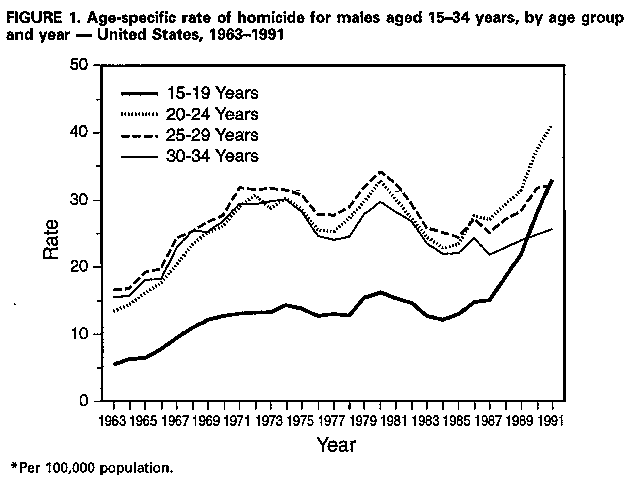 |
|
|
|
|
|
|
| ||||||||||
|
|
|
|
|
|
|
||||
| ||||||||||
|
|
|
|
|
Persons using assistive technology might not be able to fully access information in this file. For assistance, please send e-mail to: mmwrq@cdc.gov. Type 508 Accommodation and the title of the report in the subject line of e-mail. Current Trends Homicides Among 15-19-Year-Old Males -- United States, 1963-1991In 1991, nearly half (13,122 {49%}) of the 26,513 homicide victims in the United States were males aged 15-34 years. In addition, among males in this age group, homicide accounted for 18% of all deaths and was the second leading cause of death Table_1. During 1963-1991, the pattern of homicide rates changed substantially; the change was greatest for males aged 15-19 years, for whom rates increased substantially Figure_1. This report summarizes these trends and presents strategies for violence prevention and intervention. Mortality data were obtained from CDC's National Center for Health Statistics; population estimates were projected from census data. Arrest rates were calculated using data from the U.S. Department of Justice. From 1985 to 1991, the annual crude homicide rate for the United States increased 25% (from 8.4 to 10.5 per 100,000 persons). The homicide rate for persons aged 15-34 years increased 50% during this period (from 13.4 to 20.1 per 100,000), accounting for most of the overall increase. Rates increased for both sexes and all 5-year age groups within the 15-34-year age group. For persons in other age groups, rates were relatively stable from 1985 to 1991: for persons aged less than or equal to 14 years, 1.9 and 2.4, respectively; for persons aged 35-64 years, 8.8 and 9.1, respectively; and for persons aged greater than or equal to 65 years, 4.3 and 4.1, respectively. From 1963 through 1985, annual homicide rates for 15- 19-year-old males were one third to one half the rates for the next three higher 5-year age groups Figure_1. However, during 1985- 1991, annual rates for males aged 15-19 years increased 154% (from 13.0 to 33.0), surpassing the rates for 25-29- and 30-34-year-old males, even though those rates increased 32% (from 24.4 to 32.3) and 16% (from 22.1 to 25.7), respectively. The homicide rate for 20-24-year-old males increased 76% (from 23.4 to 41.2) from 1985 through 1991. During 1985-1991, age-specific arrest rates for murder and nonnegligent manslaughter increased 127% for males aged 15-19 years, 43% for males aged 20-24 years, and declined 1% and 13% for males aged 25-29 and 30-34 years, respectively (1,2). In 1991, 15- 19-year-old males were more likely to be arrested for murder than males in any other age group. Reported by: Div of Violence Prevention, National Center for Injury Prevention and Control, CDC. Editorial NoteEditorial Note: The increase in the annual homicide rate for 15- 19-year-old males during 1985-1991 was a dramatic change from the pattern during 1963-1984. Although the immediate and specific causes of this problem are unclear, the increase in the occurrence of homicide may be the result of the recruitment of juveniles into drug markets, the use of guns in these markets, and the consequent diffusion of guns to other young persons in the community, resulting, in turn, in more frequent use of the guns for settling disputes (3). Among 15-19-year-old males, firearm-related homicides accounted for 88% of all homicides in 1991 and 97% of the increase in the rate from 1985 through 1991. Factors underlying the immediate precursors may include poverty, inadequate educational and economic opportunities, social and family instability, and frequent personal exposure to violence as an acceptable or preferred method of resolving disagreements (4,5). Although the most effective strategies to prevent youth violence have not been determined, efforts to prevent this problem should employ established principles of health promotion and should emphasize the use of multiple complementary interventions (6,7). These interventions include
References
Figure_1  Return to top. Table_1 Note: To print large tables and graphs users may have to change their printer settings to landscape and use a small font size. TABLE 1. Leading causes of death for males aged 15-34 years -- United States, 1991 ============================================================================= Cause No. (%) ----------------------- ------ ----- Unintentional injury 23,108 ( 32) Homicide 13,122 ( 18) Suicide 9,434 ( 13) Human immunodeficiency virus infection 8,661 ( 12) Cancer 3,699 ( 5) Other 13,234 ( 19) Total 71,258 (100) ----------------------------------------------------------------------------- ============================================================================= Return to top. Disclaimer All MMWR HTML versions of articles are electronic conversions from ASCII text into HTML. This conversion may have resulted in character translation or format errors in the HTML version. Users should not rely on this HTML document, but are referred to the electronic PDF version and/or the original MMWR paper copy for the official text, figures, and tables. An original paper copy of this issue can be obtained from the Superintendent of Documents, U.S. Government Printing Office (GPO), Washington, DC 20402-9371; telephone: (202) 512-1800. Contact GPO for current prices. **Questions or messages regarding errors in formatting should be addressed to mmwrq@cdc.gov.Page converted: 09/19/98 |
|||||||||
This page last reviewed 5/2/01
|